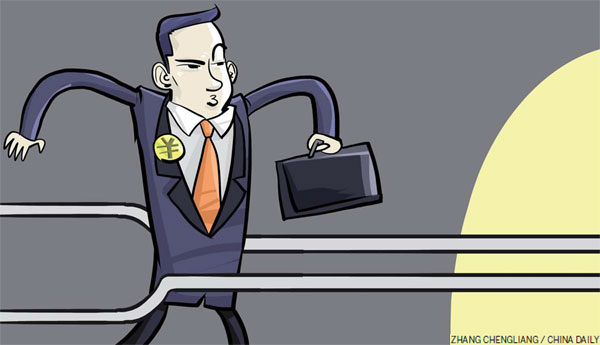Depreciation? The sooner, the better
Updated: 2016-05-13 08:28
By Zhang Ming(China Daily Europe)
|
|||||||||
Instead of asking whether China should let the yuan drop against the dollar, we should examine whether it can afford not to
From June 2005 to July 2015, the renminbi appreciated 26 percent against the US dollar. Meanwhile, the renminbi's real effective exchange rate - the weighted average relative to a basket of other major currencies, adjusted for inflation - appreciated 57 percent.
Since the second quarter of 2014, the appreciation expectation of the renminbi against the dollar in the market has been reversed to a depreciation expectation.

The key reason for the reversal is that the effective exchange rate of the renminbi appreciated too fast from 2013 to 2014, which could not be supported by economic fundamentals. In that period, the renminbi was still largely pegged to the dollar, and the effective exchange rate of the dollar appreciated very fast due to the end of quantitative easing and expectations of interest hikes.
From the second quarter of 2014 till July 2015, although there was depreciation pressure, the exchange rate of the renminbi against the dollar remained unchanged. The intervention tool of the People's Bank of China was the management of the daily opening price of the renminbi against the dollar. Before August last year, the daily opening price did not equal the closing price of the previous trading day. Therefore, the PBOC could offset the depreciation pressure by pushing up the daily opening price persistently.
To show that the PBOC is determined to decrease its intervention and to facilitate the renminbi's inclusion into the special drawing rights reserve currency basket of the International Monetary Fund, the PBOC initiated a reform of the renminbi's daily opening price on Aug 11. The key point of this move was to let the daily opening price of the renminbi against the dollar be more determined by the closing price of the previous trading day. However, because there was significant depreciation pressure on the exchange rate of renminbi against the dollar, the result of the Aug 11 reform was the sharp depreciation of the renminbi.
On the one hand, the depreciation pressure was so strong that it seemingly was beyond the expectations of the PBOC. On the other hand, the PBOC began to be criticized because the renminbi's depreciation was thought to be the critical factor, which caused turmoil in both domestic and international financial markets. As a result, several days after the reform, the PBOC was forced to intervene on the foreign exchange market again.
Because the PBOC had already given up the management of the daily price of renminbi vs the dollar, the new tool used to stabilize the renminbi's exchange rate was open market operations, which meant the central bank has to sell dollars and buy renminbi. Moreover, as a result of renminbi internationalization, there are two renminbi exchange markets now, the CNY market (onshore) and CNH market (offshore).

If the PBOC conducted open market operations only in the CNY market, the exchange rate spread between the CNY and the CNH markets would expand, which would bring about stronger pressure for renminbi depreciation.
So, although without official acknowledgement, the PBOC was believed to be conducting open market operations on both the CNY and the CNH markets to avoid depreciation of the renminbi.
However, if there is depreciation pressure and the PBOC does not allow this pressure to be released, there are certain costs. Instead of asking whether the PBOC should let the renminbi depreciate, we ought to examine whether we can afford the costs of renminbi stability.
The first cost of refusing the renminbi's depreciation is persistent capital outflow. The logic is, if there is a continuous depreciation expectation of the renminbi against the dollar, both residents and nonresidents will want to exchange their renminbi-denominated assets into dollar assets, resulting in capital outflows.
China began to incur financial account deficits in the second quarter of 2014. From the second quarter of 2014 to the second quarter of last year, the accumulated financial account deficit was $200 billion. However, the deficit increased to $160 billion and $200 billion in the third and fourth quarters of last year respectively. The reason for the worsening capital outflow was that, after the Aug 11 reform, depreciation of the renminbi was aggravated, not mitigated. If there is no significant depreciation, the PBOC's effort to stabilize the renminbi's exchange rate cannot eliminate depreciation expectations.
The second cost of refusing the renminbi's depreciation is the shrinking of China's foreign exchange reserves. By the end of January, the reserves were $3.2 trillion, indicating that the scale of this reserve had decreased nearly $800 billion from its peak.
Although the valuation effect of the fluctuations of major currencies may have contributed to the shrinking of the foreign exchange reserves, my own calculation suggests that that could explain only about a third of the shrinkage. The rest would be attributed to the PBOC's open market operations.
In fact, the real loss of foreign exchange reserves may be much larger than the abovementioned number, if some market rumors are to be believed that the PBOC tried to hide the real amount of dollar assets it sold on the market. If depreciation pressure persists and the PBOC continues to conduct open market operations, it is possible that China's foreign exchange reserve could drop below $2.5 trillion by the end of 2016. To make things worse, the fast shrinking of reserves may intensify depreciation expectations.
The third cost is the weakening of the monetary policy autonomy of the PBOC. According to monetary theory, if the PBOC can't control capital outflow and continues to maintain exchange rate stability, it won't be able to implement independent monetary policy. Under current circumstances, the economic slowdown and the exacerbation of deflation pressure require the PBOC to loosen monetary policy by lowering banks' required reserve ratio or cutting benchmark interest rates.
However, due to concerns that monetary loosening would push down the interest rate spread between China and the United States and then further exacerbate depreciation pressure against the renminbi, the central bank has postponed RRR and interest rate cuts for a long time, which not only increases the downward pressure on the real economy, but also results in stock market fluctuations. However, for a large economy like China, independent monetary policy should be considered more important than maintaining a stable exchange rate.
The final cost is the negative impact of an overvalued renminbi to China's export growth. Although China's goods trade surplus was $578 billion in 2015, the reason for the huge surplus was not the good performance of the export sector, but rather the very bad performance of import growth.
Last year, China's export growth year over year was positive only in February and June. Weak external demand was one reason behind the dismal export growth, and the strong appreciation of the renminbi's effective exchange rate was another important reason. If the renminbi continues to remain stable against the dollar and the dollar continues to appreciate against other major currencies in 2016, China's export sector will continue to face downward pressure. If the pressure is too significant, both economic growth and the labor market will suffer serious setbacks.
So if the PBOC continues to maintain the stability of the exchange rate against the dollar and refuses to release the depreciation pressure, the costs would finally become unaffordable for the Chinese economy. So the sooner the depreciation pressure is released, the better for the PBOC and for the Chinese economy.
Last but not least, to avoid the downward overshooting of the renminbi's exchange rate, the PBOC should strengthen controls on short-term capital flows to avoid a vicious spiral between depreciation and capital outflow. The government also should consolidate regulation to minimize the potential impact of depreciation, such as the bursting of dollar-denominated debts of Chinese enterprises.
The author is senior research fellow and head of the department of international investment, Institute of World Economics and Politics, Chinese Academy of Social Sciences. The views do not necessarily reflect those of China Daily.
Today's Top News
China urges EU to honor MES status, despite parliamentary vote
Generation of new imams preach peace
Streaming stars
China vows to step up anti-corruption co-op
Chinese entrants in public speaking contest fight hard
Global anti-corruption summit opens in London
Britain raises threat of terror attacks to higher level
Chinese students to benefit from EU rules easing
Hot Topics
Lunar probe , China growth forecasts, Emission rules get tougher, China seen through 'colored lens', International board,
Editor's Picks

|

|

|

|

|

|







